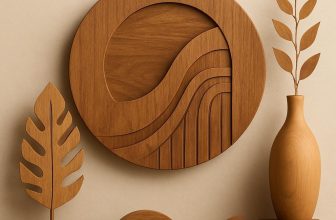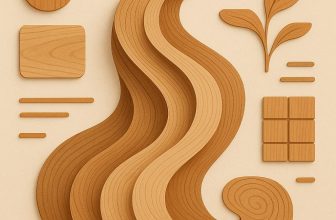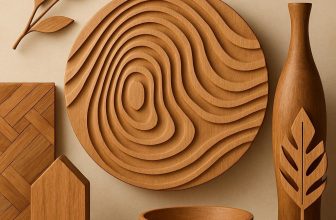
Pull up a chair in the workshop-the future is carved in grain. As 2025 unfolds, new patterns, enduring materials, and smart joinery are reshaping what we create and how we create it. For woodworking enthusiasts, staying current isn't about chasing fads; it's about expanding your toolkit, pushing your design boundaries, and transforming ordinary blocks of wood into statements of craft. This guide highlights the trends you'll see in design, tools, and finishes, and translates them into practical ideas you can try next weekend. By the end, you'll have fresh project concepts, sourcing tips, and a mindset ready to build with intent.
Trending Woodworking Styles and How to Select Projects for Modern Makers
In 2025, trending woodworking styles blend warm, tactile textures with clean, efficient forms. Japandi-inspired calm pairs light woods and restrained palettes with smart storage; Scandinavian minimalism emphasizes airy profiles and modular fixtures; Industrial Luxe adds metal accents and durable finishes for urban spaces; and organic curves and live-edge slabs bring nature into modern interiors. For modern makers, the challenge is not choosing a single look but weaving elements that fit your space, tools, and time while maintaining craft integrity.
To help you spot opportunities at a glance, consider this concise style guide. The table below highlights the core signatures, typical projects, and suggested starting skill for each trend.
| Style | Signature Elements | Ideal Projects | Suggested skill |
|---|---|---|---|
| Japandi | Light woods, clean lines, muted palette | Console, coffee table, shelving | Intermediate |
| Scandinavian Minimal | White finishes, simple joinery, airy silhouettes | Wall desk, floating shelves | beginner-Intermediate |
| Industrial Luxe | Metal accents, warm timber, matte finishes | Dining bench, media console | Intermediate |
| Organic Curves / Live-Edge | Curved profiles, natural edges | Coffee table, bench | Advanced |
How to choose projects Start with constraints-space, budget, and available tools-and let style guide the form. if you're new, pick a simple, visible piece in a familiar style and plan the build in stages: rough cut, joinery, finish, and hardware.Consider finishes early: water-based poly for durability, hard wax oil for a warm feel, or a low-VOC stain to preserve color. A practical rule is to select a project you can complete in 1-2 weekends, then level up with a small, optional feature such as integrated cable management or hidden drawers.
when designing for modern spaces, prioritize modularity and maintenance. Choose projects that can scale-think a console that can extend into a desk, or shelving that can be reconfigured as needs change. Material choices matter too: responsible pickups of sustainably sourced hardwoods,or alternative lumber such as plywood with veneer faces,help keep costs down while preserving aesthetics. To kick off your year,here are quick starter ideas aligned to your skill level:
- Beginner: wall shelf with hidden brackets (Scandinavian Minimal) – quick,neat,minimal tools.
- Intermediate: coffee table with built-in magazine rack (Japandi)
- Advanced: live-edge side table with metal hairpin legs (Organic Curves / Industrial luxe)
Build your Dream Workshop on a Budget →
Sustainable Materials and Finishes for Modern Woodworking Projects
Choosing sustainable materials starts with sourcing. Favor FSC-certified wood, reclaimed lumber, and rapidly renewable options like bamboo. Local suppliers reduce transport emissions. Consider lifecycle: can scraps be repurposed? Will the finish last? Plan to extend a piece's life through durable design.
Eco-friendly finishes protect your work and indoor air quality. Look for low-VOC or zero-VOC options such as water-based polyurethanes, acrylics, and shellac that is de-waxed and responsibly sourced. For a natural look, try oil finishes with linseed or tung oil, applying thin coats and wiping away excess. Always work in a well-ventilated area and allow ample cure time between coats. To help you compare quickly,here is a concise snapshot of common finish options:
| finish Type | Best Use | Pros | Cons |
|---|---|---|---|
| Water-based polyurethane | Interior furniture | Low odor,quick dry | Can raise grain if not properly sanded |
| Oil finishes (linseed/tung) | Natural look,warm tone | Enhances grain,easy repair | Longer cure times,moisture sensitivity |
| Shellac (dewaxed) | Decorative surfaces,trim | Fast-drying,warm appearance | Not highly durable in moisture or heat |
Beyond materials and finishes,implement a sustainable workflow. Invest in dust collection,minimize waste,and repurpose scrap wood for jigs or small projects. Choose joinery techniques that reduce offcuts and optimize layout to maximize yield.Store offcuts by size for reuse and consider finishing multiple pieces in a single session to minimize solvent use and setup time.
For hands-on inspiration, try these quick project ideas that keep sustainability in focus: a wall shelf using reclaimed pine with a clear water-based coating; a coffee table built from FSC plywood with a wipe-on oil finish; a minimalist plant stand from bamboo with a hard-wax oil; or a small serving tray from offcut hardwoods with a hand-applied shellac for a warm, durable sheen. Always test finishes on a scrap sample and document sources for future projects.
Build Your Dream Workshop on a Budget →
Bold Textures and Finishes to Elevate Your Craft
Bold textures invite touch and depth to any piece. For 2025, the craft scene leans into tactile surfaces that reveal the hand-wire-brushed grains, hand-planed valleys, and subtle chisel marks that tell a story. Pairing rich hardwoods with lighter finishes enhances contrast while keeping the surface inviting to the eye and the fingers. The goal is furniture that feels alive,where every contour reads as a signature of craft rather than a factory finish.
Textures are more than appearance; they set mood. Try wire-brushing to emphasize growth rings, or hand-planing across a panel to create gentle ridges. For a dramatic effect, a light char or burnish can deepen grain without dulling warmth. If you crave a bold statement, explore Shou Sugi Ban-style scorching on cedar or ash, then seal with a penetrating oil to preserve the contrast while staying craft-friendly and durable.
Finishing strategy matters as much as the texture itself. Start with a oil-based or wax-based base to saturate the wood, then introduce a matte topcoat or a low-sheen polyurethane to keep texture visible and wipe-clean. For a modern glow,apply a tiny amount of mica or pearl pigment in a clear coat-enough to shimmer subtly in the light without creating glare. Keep maintenance simple: dust regularly, reapply a light oil or wax seasonally, and avoid heavy solvents that dull tactile detail.
| finish Type | Texture Effect | Best For |
|---|---|---|
| Oil (Tung/Danish) | Deep saturation; grain pops | Tables, cabinetry |
| Matte Lacquer | Low sheen; texture remains visible | Desks, panels |
| Wire-Brushed + Wax | Prominent grain; silky touch | Accent pieces, shelving |
| Charred (Shou Sugi Ban) | High contrast; dramatic grain | Statement furniture |
Build Your Dream Workshop on a Budget →
Space Saving Modular Designs for Compact Workshops
For 2025, space-saving strategies in woodworking favor modular, scalable setups that grow with your ambitions.Compact workshops don't mean compromise; they mean clever association, multi-use surfaces, and rapid reconfiguration. Start by sketching a grid of zones: cutting, assembly, finishing, and storage, then choose modular units that snap together with quick-release hardware rather than permanent jigs. The goal is to keep essentials within reach while tucking away clutter when a project is done.
Vertical storage, foldable surfaces, and mobile stations are the pillars of an efficient micro shop. Vertical racks keep blades, clamps, and consumables off the benchtop; fold-down work surfaces open for large tasks and fold away for sanding or routing; modular carts with integrated power can roll to the best light or be stashed in a corner between projects.
To visualize potential footprints, consider a compact bench module with configurable sizes and easy add-ons. The following quick-reference layout keeps essentials accessible without crowding the floor space.
| Component | Size (in) | Primary Benefit |
|---|---|---|
| workbench Platform | 48 x 20 | Stable surface for assembly |
| Storage Cabinet | 24 x 18 | Tools within arm's reach |
| Accessory Dock | 12 x 12 | Jigs and clamps quick-access |
Turn concepts into action with a quick 2-hour reconfiguration plan: pick two modular components to swap,re-route cords to maintain safe pathways,and test a project workflow from prep to finish. By prioritizing visibility, accessibility, and walk space, you'll create a flexible workspace that supports both detailed work and big projects without sacrificing safety or comfort.
Build Your Dream Workshop on a Budget →
Outdoor and Weather Resistant Woodworking Ideas for All Seasons
Outdoor and weather-resistant projects start with selecting the right materials and grounding your design in climate realities. For all-season performance, choose naturally rot-resistant woods like Cedar, Redwood, Teak, or Ipe, or opt for durable composites where moisture and UV are persistent. Before you cut, seal, and assemble, plan for drainage, overhangs, and proper ventilation to reduce water retention. Use stainless steel or galvanized fasteners to resist rust, and consider hidden joinery or pre-drilled pilot holes to keep surfaces smooth after exposure to sun and rain.
Turn these materials into flexible outdoor pieces that stay usable year-round. Build a modular seating set with removable cushions, a planter box with built-in drainage, or a trellis that doubles as a shade screen. For weatherproof finishes, apply a penetrating oil for cedar or spar varnish on teak, and consider a UV-blocking sealant on softer woods. When assembling, rely on corrosion-resistant hardware and weatherproof hidden connectors so the look remains clean as seasons change.
| Wood Species | Best For | Durability (1-5) | Maintenance Tips |
|---|---|---|---|
| Cedar | Decks, planters, furniture | 3 | Annual oil or sealant |
| Redwood | Fences, benches | 3 | Clean and recoat every 1-2 years |
| Teak | High-end outdoor furniture | 5 | Occasional washing; optional oil |
| Ipe | Structural outdoor projects | 5 | Oil every year or two; keep joints clean |
Seasonal maintenance keeps projects sturdy and attractive. In spring, inspect joints, reseal exposed surfaces, and re-oil cedar or teak where the finish has faded. Summer calls for shade management and periodic cleaning to remove mildew. Fall is a good time to sweep gutters around outdoor structures, treat ends with a sealant, and store cushions in a dry space. Winter, when frost risk is higher, cover or store delicate pieces and check fasteners for rust, replacing as needed to prevent loose components.
Build Your Dream Workshop on a Budget →
Practical Plans and Process Steps for Efficient project Execution
to execute projects efficiently, start with a clear brief that aligns with 2025's wood aesthetics, modular design, and greener practices. Define the scope and establish measurable goals: piece count, fit, finish, and delivery date. Build a concise cut list and quick render or model, then prioritize materials that balance cost, performance, and sustainability. Design the shop layout in zones for cutting, shaping, joining, and finishing so decisions are fast on the floor, not on the clock. A solid planning layer minimizes waste and keeps exploration focused on tangible results.
With the plan in hand, create a time-boxed production rhythm that keeps momentum while preserving quality. Batch tasks (cut similar parts together, sand a batch at once, and apply finishes in a controlled sequence) to reduce setup time and tool changes. Build a simple weekly calendar that blocks time for cutting, assembly, and drying, leaving a safety buffer for tweaks. Invest in a few high-quality jigs and fixtures that you can reuse across projects, turning routine steps into repeatable, reliable operations.
| Phase | Activity | Suggested Time |
|---|---|---|
| Design | Finalize plan and cut list | 2-4 hrs |
| Cutting | Rough and accurate cuts | 1-2 hrs |
| Joinery | Dry fit and assembly | 3-5 hrs |
| Finishing | Sand,stain/finish,cure | 2-6 hrs |
Quality control is built into the flow,not tacked on at the end. Inspect stock quality before cutting-check for warps, splits, and moisture content. During assembly, perform a dry fit to catch misalignments early, and document adjustments so you can replicate success. Keep a lightweight risk log that tracks potential blockers (supply delays, tool wear, finish setbacks) and predefine simple workarounds to avoid derailment.
codify learnings and future-proof your process. Create a brief post-project recap that notes what worked, what didn't, and any material or tool choices worth repeating. Store digital cut lists and reference photos in a centralized folder, and tag projects by trend (for example, exposed joinery, clean lines, and warm woods) so you can reuse patterns when inspiration strikes in 2025 and beyond.
Build Your Dream Workshop on a Budget →
Q&A
Which woodworking styles are making waves in 2025?
Japandi, with clean lines and warm, tactile finishes, remains a standout, while mid-century silhouettes keep their timeless appeal. Live-edge pieces are refined rather than flashy, offering natural drama without loud ornament. For practicality, pair light woods with earthy oils and simple hardware to maintain a cohesive look.
what materials and finishes align with 2025 trends?
Prioritize sustainably sourced wood-reclaimed stock and FSC-certified species-along with locally available timbers. Favor low-VOC finishes and water-based products to preserve color and character. Subtle epoxy accents or inlays can read as contemporary without overpowering the design.
How can beginners start incorporating these trends without a major overhaul?
Start with small, trend-friendly projects like a simple end table or a floating shelf in a spare minimalist style.Pick one trend to follow and limit yourself to 2-3 materials to keep things manageable. Build confidence with common joints (pocket screws or basic mortise-and-tenon) before tackling complex curves.
What tools or techniques are becoming essential for trendy projects?
Invest in a reliable dust collection setup and accurate saws to maintain quality with clean lines.Digital templating or a basic CNC router can speed up consistent curves, while steam bending opens up smooth, graceful shapes. A solid sander, clamps, and a versatile finish kit help you adapt finishes across different woods and tones.
Closing Remarks
Ultimately, the message of 2025 is clear: let curiosity drive craft, and let thoughtful choices guide each piece. The year blends sustainable materials, clean lines, and warm, tactile finishes with a touch of personal storytelling, so your work feels both current and your own. For woodworking enthusiasts, this matters because trends are not just about looks-they're about evolving skills, smarter material choices, and projects that fit real life. So, pick up a project you've been meaning to start, or dive into another guide, then apply what you've learned to your next build. Stay patient, stay bold, and let your workshop hum with possibility.







Love the inspiration in this guide! Can’t wait to try out some of these trending styles in my next project!
These ideas are fantastic! I’m especially drawn to the sustainable woodworking trends – it’s great to see eco-friendly designs gaining popularity.
Absolutely loving the creativity in these styles! The mix of modern and rustic elements really speaks to me, and I can’t wait to implement some of these ideas in my woodworking this year!
I’m amazed at how innovative these woodworking trends are! The blend of functionality with aesthetic appeal is captivating, and I’m excited to experiment with some of these unique ideas in my workshop!
These woodworking styles are truly inspiring! I’m particularly excited about the minimalist trend-less really can be more, and it’s a perfect way to showcase the beauty of the wood itself. Excited to see how these ideas can transform my space!
I find it fascinating how these woodworking trends embrace both tradition and modernity! The emphasis on personal expression through custom pieces really resonates with me, and I can’t wait to see how these styles will influence my own creations in 2025.
I’m really excited about the resurgence of handcrafted techniques in woodworking! It’s wonderful to see a focus on artisanal skills and sustainable practices that connect us back to nature while still allowing for innovative designs. Can’t wait to try out some of these ideas!
I’m really intrigued by the idea of eco-friendly materials making their way into new woodworking designs! It’s great to see how sustainability is becoming a key aspect of craftsmanship, and I’m eager to explore how I can incorporate that into my projects for 2025.
I love how these woodworking trends highlight the importance of personal creativity and individuality! It’s exciting to think about how we can all put our unique spins on traditional styles and techniques to create something truly special in our projects this year.
I’m thrilled to see the blend of technology and traditional craftsmanship in woodworking for 2025! The incorporation of smart features into furniture and decor not only makes pieces more functional but also adds a modern twist that can really elevate our living spaces. Can’t wait to experiment with these innovative ideas!
I’m absolutely loving the emphasis on multifunctional furniture in the upcoming woodworking trends! It’s such a practical and stylish way to maximize space, especially in smaller homes, and I can’t wait to incorporate these clever designs into my own woodworking projects for the year ahead.
The integration of biophilic design in woodworking trends for 2025 is absolutely inspiring! Bringing natural elements indoors not only enhances aesthetics but also promotes well-being, and I can’t wait to experiment with ways to incorporate organic shapes and materials into my creations.
The focus on minimalist designs in woodworking for 2025 is so refreshing! It allows for clean lines and simplicity, making pieces timeless and versatile, and I’m excited to see how I can incorporate this aesthetic into my own projects while still keeping them functional and inviting.